This particular post will be an overview of an off grid solar project I've been working on for the last few years. It's being built with as many recycled components as possible, and the cheapest components possible for the things we have had to buy new. I'll do more detailed posts about several individual aspects of these builds in the future. For now, get comfortable as we dive into the story of...
Bringing Electricity to Mother Bill Farm
For reasons still unknown, the local utility refused to hook up so much as a construction meter, so he accelerated his plans to get the solar power hooked up, while I went back to my boring job paving.
He had already begun experimenting a bit with a DIY storage battery made from end-of-life Nissan Leaf batteries. I had hooked those batteries up to an inverter/charge controller that he paid a premium price for, and it worked well, briefly. At that time, he didn't even have any solar panels yet, and was charging the batteries with a generator. After running for a short time, the charge circuit in that unit began malfunctioning, and it wouldn't charge the batteries anymore. Unfortunately, I don't have any photos of that first setup.
After that, the cabin was powered from just a generator, while we did some more research on what it would take to get a working off grid power setup. We knew the basics were batteries, a matching inverter, a suitable charge controller, and a power supply.
We already had the batteries, which worked okay, and my friend found a Battery Management System (BMS) online that helped keep the individual cells inside the battery modules balanced while charging and discharging. It was a DIY kit designed to work specifically with the Nissan Leaf battery modules we already had. The end product of those battery builds can be seen in the blurry photo below.
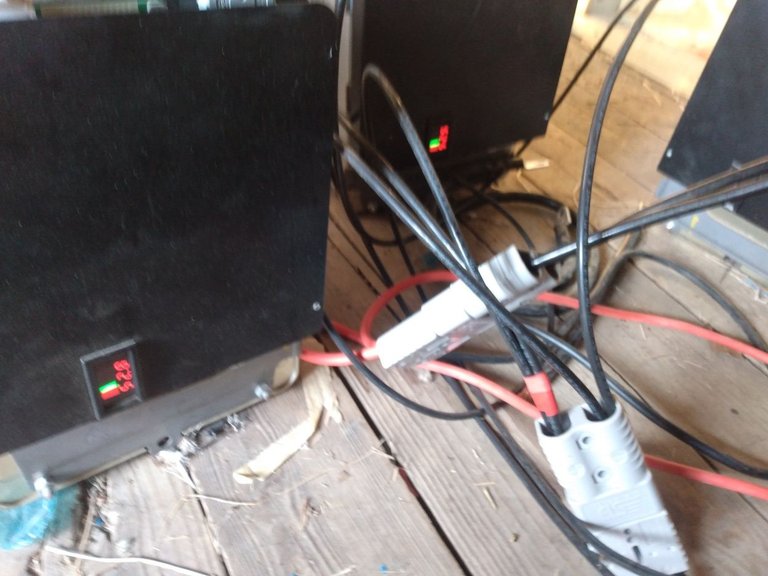
Aside from lengthening the life of the batteries, the BMS provides an extra layer of safety from catastrophic failure by automatically disconnecting the battery in the event of overcharge or abnormal discharge.
His father and another friend scavenged an old farm trailer and converted it into a mobile power station, with solar panels on top, and room for our batteries and control modules inside. It was initially built on the trailer so as not to violate local codes prohibiting the installation of solar panels on permanent structures, but in the long run, there are many things about this set up that we like better. I'll go into more detail about our mobile test kitchen in a different post.
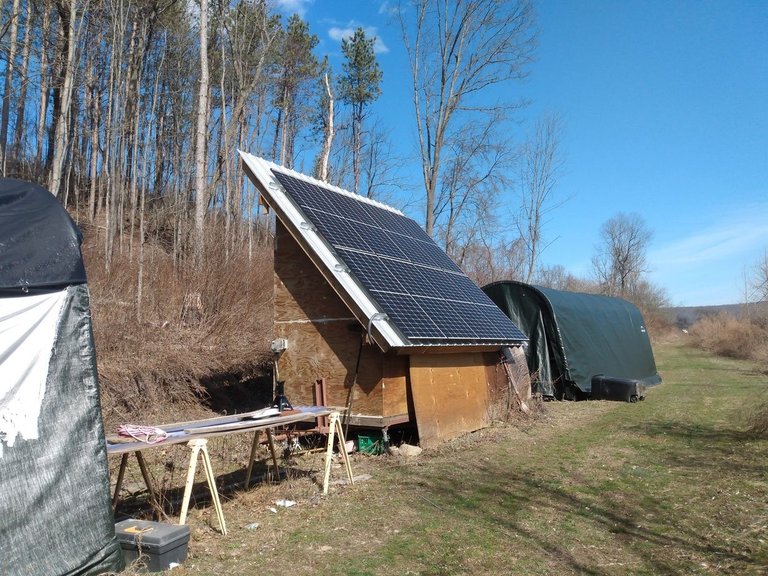
I had found an inverter on eBay that should have been suitable for our needs, and my friend found a guy in a nearby town who was supposed to have a charge controller, and the experience to come hook everything up. Unfortunately, he didn't actually know what he was doing, and installed a charge controller that was incapable of handling the voltage from the solar panels.
The test kitchen sat unused again for a while after that, with my friend unwilling to trust anyone else with it until I had time to devote to it. I eventually did find time, and a suitable charge controller, which I promptly installed.
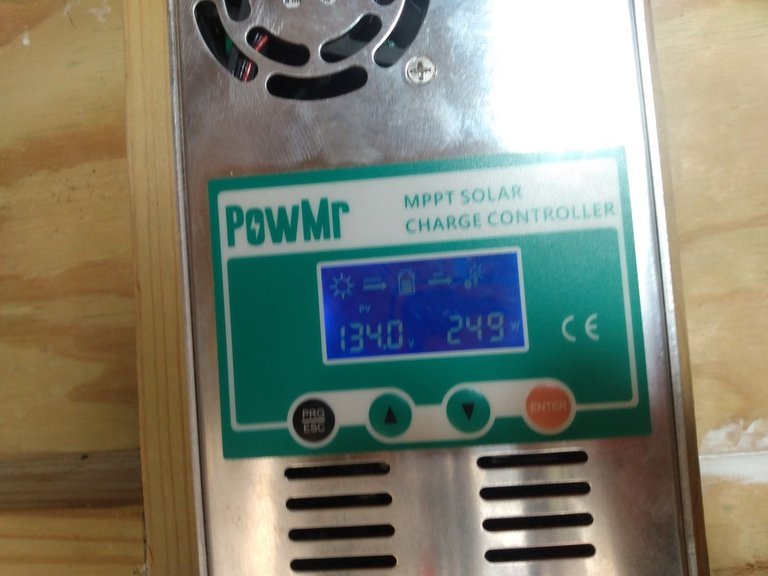
After getting everything hooked up, we still didn't have power, and it didn't take long to figure out why...
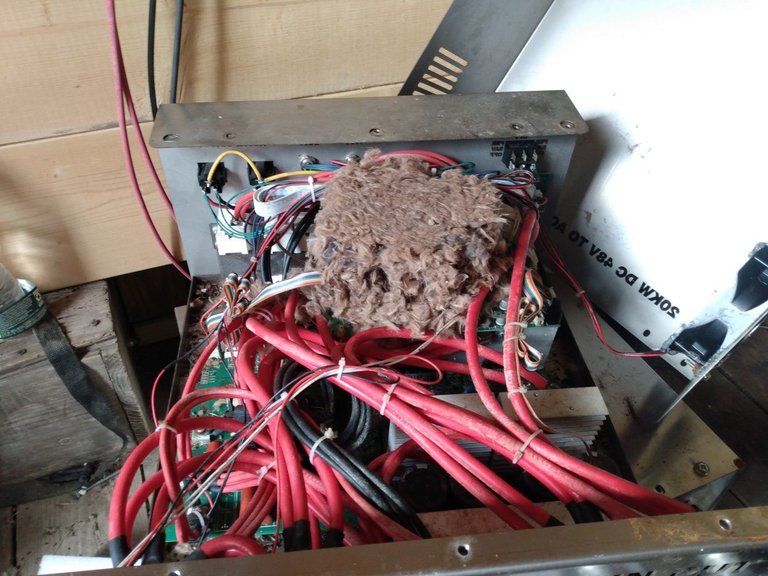
What you see in the photo above is a large mouse nest inside the control portion of the inverter we had purchased. The widest opening on this stainless steel enclosure was only 1/4" wide, so I'm still not sure how they ever got inside this thing. They did manage, and chewed up several wires, as well as urinating all over most of the inside, which caused accelerated corrosion on several connectors. I made a few attempts to repair this unit, and still haven't given up, but I still haven't won yet, either.
Although this was another setback, it didn't actually set us back for long. Soon after discovering this mess, I found someone fairly local online who was selling a used industrial grade inverter set, in a nice rack mount.
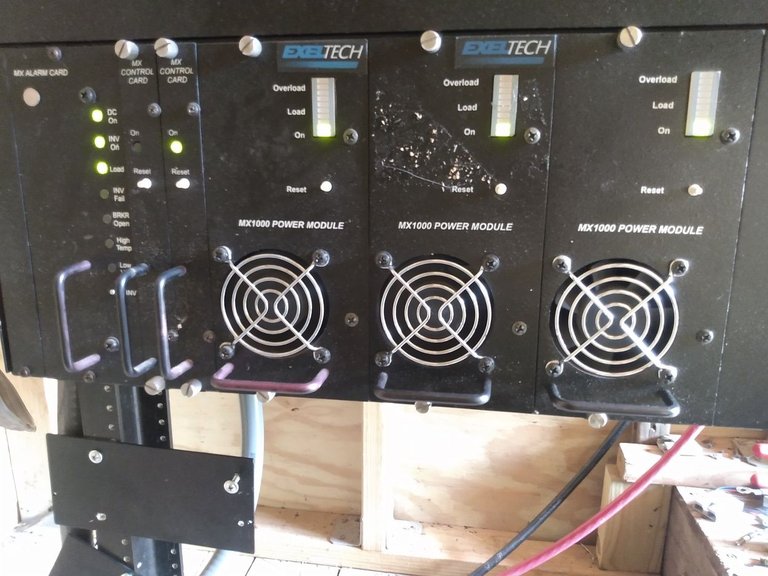
Each of those MX1000 modules gives us another 1000W of power handling. There are two more in racks above the space you see in the photo, for a total of 5000W. Modules can be hot swapped in and out without even turning the unit off, and it has redundant backup systems that mean basically this unit will never fail. It certainly hasn't failed us yet, or even switched to backup systems.
With all the proper components finally acquired, I was at last able to finally get everything hooked up, and we finally had power! It still wasn't perfect though, because our inverter only output 110VAC, which was fine for almost all of our appliances. The water pump, however, required 220V split phase AC. We were able to find a transformer to handle this conversion for us at a very reasonable price from a guy who installs a LOT of solar stuff, and we had him come down with his truck full of big wires and fancy connectors to make our installation a bit prettier.
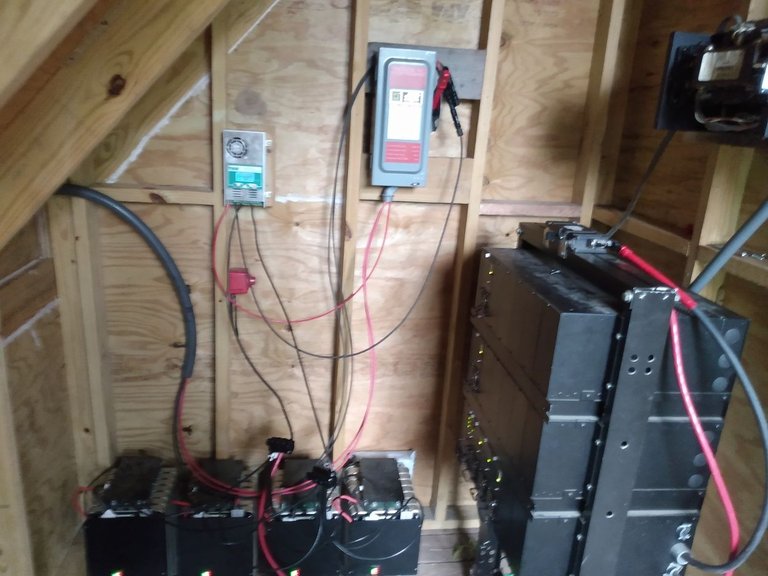
This suited our purposes for a while, but we quickly found ourselves wanting some extra battery storage. The 4 batteries were enough storage for about 2 days if it was cloudy, and if we didn't use much power at night.
I'll save the rest of that journey for another post, since this one is already getting pretty lengthy. I hope you've all enjoyed following along through our missteps, frustrations, and eventual triumph.
What a great post! You can't install solar panels on a permanent structure? Why not? That's ridiculous, but mounting them in an old trailer is superb!
Best wishes and have a great weekend
This is conservative country... we have many silly rules against progress! 🤷♂
Where you be Nathen? Been, going, you know what I mean. It's been a minute, I hope this finds you and yours well.
You made my day, thank you. Time flies by! Currently in the UK for a couple of weeks. Families....
Thank you again mate, you of course are one of the very few reasons I still bother logging in here, All my love love and best wishes to you, Pura and Atlas :-)
It's always such a good moment when the power is finally on. Hopefully your story will encourage others to keep at it too.
Congratulations @paradoxtma! You have completed the following achievement on the Hive blockchain And have been rewarded with New badge(s)
Your next target is to reach 25000 upvotes.
You can view your badges on your board and compare yourself to others in the Ranking
If you no longer want to receive notifications, reply to this comment with the word
STOP